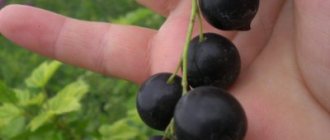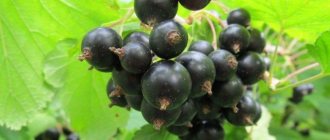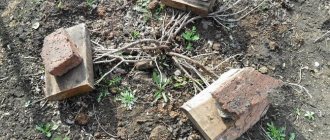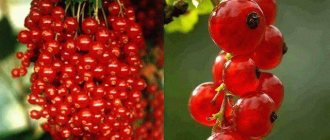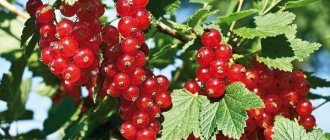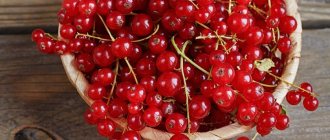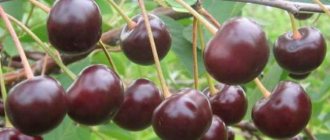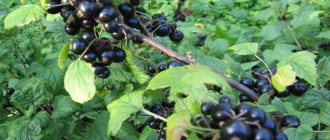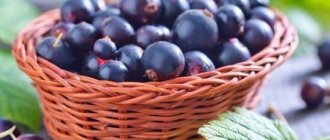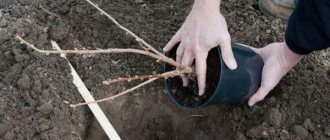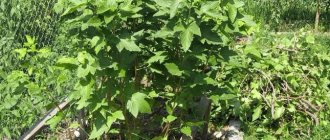Description of the Belarusian sweet currant variety
To understand whether black currant bushes of the Belorusskaya sweet variety are needed on the site, you need to know the description, size and taste of the berries. The plant is unpretentious and is recommended for growing by beginning gardeners. It is recommended to plant bushes in open sunny places, but they also grow and bear fruit well in partial shade.
Features of the bush
The bushes of the variety are vigorous, medium spreading. The height of adult shoots is about 1.2 m. The plant is round in shape with a powerful bushy structure of erect stems. Sprouts at the roots grow every year, branching begins annually, and already in the 3rd year the first harvest is harvested.
Currants have 4 types of shoots:
- mixed;
- fruit;
- bouquet;
- ringlets.
Young shoots are pubescent, matte in color, and the top is pink-violet. Older stems are already lignified, gray in color with strong pubescence.
Shoots of different ages form the basis of the bush's skeleton. Stems at the age of 8 years need to be cut out, since fruiting on them is sharply reduced.
Important! After 15 years of cultivation, Belarusian sweet currants must be replaced with a new plant.
The roots of young plants are shallow, within 30 cm. In adult bushes they go to a depth of up to 2 m. This must be taken into account when planting bushes, since the close occurrence of groundwater can negatively affect the root system.
Kidneys
Belarusian sweet currants are distinguished by thin, medium-sized buds. They are elongated and have a sharp tip. The color of the buds is pink-gray. These parts of the plant are located on different parts of the stem. Kidneys are:
- sleeping;
- height;
- flowering
Thanks to the growth buds, black currants sprout new basal shoots. Flower buds are responsible for fruiting. As for dormant buds, they are the so-called reserve, helping the plant survive in extreme conditions.
Description of leaves
Belarusian sweet currant differs from other varieties in light green leaves with 3 or 5 lobes. The middle shoulder blade is powerful. The leaf blades are matte, wrinkled with wavy edges. The denticles along the edge of the leaf are well defined. The leaves are held on a long red-violet petiole.
Flowers
Black currant variety Belorusskaya sweet is a self-fertile plant. The flowers are faded, with a yellowish-green or soft pink tint, as in the photo below. The inflorescence shape is a bell with 5 petals. On one inflorescence there are simultaneously open flowers and closed buds.
Important! Currants bloom sequentially, which is why the fruiting of the variety is extended, as is the harvest.
Brushes and berries
The flower raceme is up to 7 cm in length, it contains from 6 to 9 berries, which are attached to medium-length stalks. The fruits of the Belorusskaya sweet variety are round, fragrant, of different sizes: the first berries are larger than the next ones.
After setting, the fruits are green, then begin to turn brown, and by the time they ripen they become dark purple. Berries with shiny, dense skin. The weight of the fruits is up to 3 g, each of them contains about 37 seeds.
Comment! The berries need to be collected in a timely manner, as overripe currants fall off.
If you look at the chemical composition of the berries of the variety, they contain:
- sugars – 7.5%;
- dry matter – 15.3%;
- titratable acidity – 1.8%;
- vitamin C – 239.0 mg/100 g;
- pectin substances in wet weight – 1.3%.
Attention! Due to the presence of ascorbic acid, the fruits are sweet and sour.
When creating the Belarusian sweet blackcurrant variety, scientists expected that it would be grown in 10 regions. Today the plant grows safely and bears fruit in 45 regions of Russia.
Appearance, characteristics of berries, ripening time, yield
The berries of the Belarusian variety are dense, black, round. According to the description of gardeners, the fruits are very sweet, with a slight sourness and a pleasant aroma. Weight - 2-3 g; from one bush you can collect about 5 kg of berries. The fruit contains a huge amount of ascorbic acid, potassium, calcium, copper, B vitamins and vitamin E. 100 g of berries - 44 kcal. The variety begins to bear fruit at the end of June.
Characteristics of the variety
It’s not just the description of blackcurrants that interests summer residents and farmers. You also need to know the characteristics of the Belorusskaya sweet variety. The choice of crop depends on the yield, the possibility of growing in different regions, and plant resistance to diseases and pests.
Drought resistance, frost resistance
The Belarusian sweet blackcurrant variety, as gardeners note in reviews, can tolerate short-term drought. As for the winter hardiness of the variety, the plant tolerates cold with virtually no losses if the roots are covered in the fall. But return frosts can damage the first flowers.
Productivity and fruiting
Belarusian sweet black currant is popular due to its high yield. Up to 3 kg of sweet and sour berries are collected from young bushes. On older currants from 5 to 12 years old, 5-6 kg.
You should not wait for the fruits to ripen along the entire length of the cluster. The berries must be picked as they ripen, otherwise part of the harvest will end up on the ground. In the July heat, the berries on top can be baked.
Belorusskaya currant is a medium-ripening variety. The first berries are harvested in mid-July. The crop begins to bear fruit in the next season after planting.
Area of application of fruits
A variety of universal use, and all parts of the plant are useful: leaves, shoots, buds. The plant is used:
- for medicinal purposes;
- for preparing vitamin tea, kvass, as a spice for pickling cucumbers and tomatoes;
- for the production of juice, compote, homemade alcoholic drinks;
- to obtain delicious jam, jam, marshmallows;
- as an excellent raw material for pies.
Attention! Black berries of the Belorusskaya sweet variety tolerate freezing well, they retain beneficial qualities and vitamins.
Since the berries tear off when picked without releasing any juice, they can be stored in the refrigerator for about a week. Dense berries do not lose their presentation during transportation and do not leak.
Resistance to diseases and pests
Black currants are weakly affected by fungal diseases, in particular powdery mildew and anthracnose. The kidney mite becomes infected less frequently. But aphids can cause a lot of trouble.
Advantages and disadvantages of the variety
When choosing a blackcurrant variety, it is important to know the positive and negative aspects of the plant.
Advantages:
- Fruiting begins 2 years after planting.
- The variety is self-pollinating.
- Early harvest time.
- High and stable yield, increasing after 4 years of cultivation.
- Excellent taste of berries, preserved during transportation and storage.
- Universal culinary use.
- The plant is frost-resistant and drought-resistant.
- Possibility of propagation by cuttings and layering.
- Resistance to some diseases and pests.
Flaws:
- different sizes of black fruits on the same cluster;
- uneven ripening;
- infection by certain fungal diseases.
The Belorusskaya sweet variety has many more advantages than disadvantages. Therefore, black currant has deservedly been popular for several decades.
Main pros and cons
Belarusian sweet currant stands out thanks to:
- self-pollination;
- early fruiting;
- stable yield, which increases after the first four years;
- berries that are distinguished by their pleasant taste and ability to withstand long journeys;
- frost and drought resistance;
- resistance to a number of diseases and pests.
The main disadvantage of the crop is that the berries on one cluster ripen unevenly.
Currants, despite being drought-resistant, require regular watering. However, with excessive moisture intake, fungal diseases develop.
Landing rules
If you have experience in growing black currants, then planting the Belorusskaya sweet variety will not be difficult. Everything happens traditionally:
- site selection;
- preparation of holes and soil;
- preparation of seedlings;
- further care, including protecting the bush from diseases and pests.
Recommended timing
You can plant black currants early in the spring, before sap flow begins, and in the fall. Experienced gardeners choose autumn planting. In their opinion, the best time is September to mid-October.
Attention! The Belorusskaya sweet variety must be immediately planted in a permanent place, since transplants have a negative effect on growth and yield.
Choosing a suitable location
When choosing a place for black currants, preference is given to:
- Non-wetland area with loamy soil.
- The height of groundwater is at least 1 m from the surface.
- You can plant bushes in open places, but it is best between fruit trees, since the berries do not bake in the openwork shade in the heat.
Selection and preparation of planting material
The future harvest of black currants of any variety depends on the quality of the seedlings.
Selection rules:
- Bushes of the 1st or 2nd year of life take root best.
- Seedlings should not have damage, signs of disease or insect damage.
- The root system should have lignified skeletal roots 15 to 20 cm long.
- The length of the shoots is from 30 to 40 cm.
Features of preparing Belarusian sweet seedlings for planting:
- remove damage to stems and roots, if any;
- soak overnight in plain water or Kornevin solution;
- Before planting, dip the root system in red clay mash.
Landing algorithm
Planting Belarusian sweet currants, according to gardeners, is no different from the traditional scheme:
- Preparing holes measuring 50x50x50 with a step between bushes of at least 1.5 m, between rows - 2-2.5 m.
- Laying a drainage layer up to 10 cm.
- Filling the hole up to half with a nutrient composition of rotted manure and wood ash: 1 cup for half a bucket. Fill with water to settle the soil.
- Place the blackcurrant seedling in the center of the hole, tilt it at an angle of 45 degrees, as in the photo below. The root collar should be buried 5 cm.
- Sprinkle with the remaining soil, compact and water. It is advisable to immediately mulch the surface to retain moisture.
After this, prune the seedlings, leaving 4-5 buds. You should not spare the shoot when removing it, because stronger shoots will appear from the remaining buds, since only they will get the nutrients.
Agricultural technology plants
To get a good harvest of this round-fruited plant, it is necessary to properly care for it.
Currant propagation
The traditional method of reproduction is division. To do this, the bush is dug up and divided into parts. If it is planted in a new place, a new plant will form.
Advice. More often, the plant propagates using lignified cuttings. They are harvested from the mother bush by cutting off annual shoots. They are planted in spring or autumn.
The soil
Small slopes and non-wetlands are suitable for currants. Gives good yields on loamy soils. They must drain well and retain water. Groundwater should be at a depth of about 1, or even better, 1.5 m.
Wet soil is not suitable for currants. It will not grow next to sedge: this plant is a source of goblet rust.
The harvest depends on the soil
The soil needs to be prepared before planting: add manure to the hole and sprinkle it with soil. If there is no manure, then peat with mineral fertilizers is used.
Planting, watering and fertilizing
During planting, you should calculate the amount of water so that there is a bucket of water per bush. Subsequently, watering occurs during the berry filling period as needed, depending on weather conditions. To properly moisten a soil layer 40 cm deep, up to three buckets of water are needed.
During flowering, fertilizing with nitrogen types of fertilizers is necessary, while filling the berries - with universal fertilizers, and after picking the berries - with potassium and phosphorus.
Important! The bushes must also be treated against pests, despite the fact that this large-fruited variety is resistant to diseases. Pest control products will not harm the environment, but will help the plant
Growing technologies
To obtain a large harvest and large-sized berries, it is advisable to practice intensive growing technology. To do this, the bushes are planted half a meter apart in the row. Leave one and a half meters between each row. The bushes are kept small through intensive pruning. With this technology you can have a large number of medium-sized berries.
Note! To get large berries, bushes should be planted rarely. Leave up to 2 meters of free space between plants
In this case, the plant will not get sick often, and caring for it will be much easier.
Care instructions
In order for the Belarusian sweet currant variety to bear fruit, it is necessary to properly care for the plant:
- You should choose the right place to plant the plant. It should be protected from strong winds and well lit. Swamps should not form in it. The soil acidity index should not be higher than pH 7;
- It is better to plant currants before October 15th. Transfers should be avoided;
- It is necessary to create conditions for any type of pollination;
- The buds need to be able to grow. To do this, the bush is initially planted at an angle of 45º;
- After winter, it is recommended to do spring pruning;
- Regular watering of the plant should be observed, at the rate of up to 10 liters per bush;
- Before watering, you need to loosen the soil. Weeding also needs to be done;
- Currants need to be sprayed with a solution of copper sulfate, 2 times during the season;
- When preparing the bush for the winter, you should remove all dried leaves and tie it closer to the roots;
- The distance between bushes must be maintained at least one and a half meters. This is due to the fact that the plant grows intensively and each bush needs enough space.
Note! In the middle of winter in frosty weather, agronomists recommend watering the bush and the ground underneath it with boiling water. This will increase the weight of each berry and will be a good hardening
A good harvest is impossible without thinning and renewing the stems. For better branching, branches should be shortened. From the sixth year of life, old shoots need to be replaced by complete pruning.
Aftercare
Subsequent care for Belarusian sweet blackcurrant is no different:
- In the spring, moisture-recharging irrigation is carried out, in the summer as necessary, if the year turns out to be dry. You need to stop watering 2 weeks before picking the berries, otherwise they will begin to crack.
- Regular loosening.
- Weeding, since pests most often settle on weeds and can attack currant bushes.
- Feed the bushes 3-4 times per season with organic or mineral fertilizers in the tree trunk circle.
- Carrying out sanitary pruning in the spring and during the summer (dry and diseased shoots).
Pegs are driven in around the perimeter of the bush, onto which the crossbars are attached. Shoots will fall on them. According to gardeners, the Belarusian sweet blackcurrant variety does not need to be tied to each stem.
In autumn, fallen leaves are removed and water-recharging irrigation is carried out. With the onset of the first frost, the tops of the shoots are shortened by 2-3 cm, and the root system is covered with humus or compost. In winter, mice can bother currants. Many gardeners sprinkle rodent repellent between the shoots before digging the roots.
Further care for currants
To achieve success in growing a crop, it is worth providing it with complete and high-quality care. It must be comprehensive and include important elements.
Description and characteristics of the Versailles white currant variety, planting and care
Read
Watering mode
After the snow melts, the plants should be watered as needed. This is done when the soil dries out.
It is important to avoid overmoistening it. A couple of weeks before harvest, you should stop watering
Excess moisture provokes cracking of the fruit.
Loosening and mulching the soil
The soil under the bushes must be clean. When using a mulch layer, it should be updated periodically.
Loosening the soil is of no small importance. This procedure allows you to saturate the roots with oxygen and nutrients.
Fertilizer application
During the flowering period, the bushes should be fertilized with nitrogen substances. As the fruits ripen, complex fertilizers are used. After harvesting, it is worth using formulations based on potassium and phosphorus. Organic matter contributes to the development of culture.
Pruning: formative, sanitary, rejuvenating
To get a good harvest, it is worth updating and thinning the bushes in a timely manner. The first pruning is done when planting the plant. The second procedure is carried out a year later. In this case, it is recommended to leave the 4 most powerful shoots. At the 3-4 year of life, 3-6 of the strongest zero branches should remain.
To achieve better branching, it is recommended to shorten the shoots. This procedure is performed after harvesting. In this case, the branches are cut by a third.
Belarusian sweet is considered a long-lasting crop. The maximum yield is provided by shoots aged 6 years. Therefore, this variety is pruned 2-3 years later. The specific timing depends on the condition of the bush.
Dousing and hardening off bushes
To cope with parasites and pests that overwinter in the bark and soil under the bush, the plants should be watered with warm water. Its temperature should be about 60 degrees. This procedure is performed in the spring, before the buds open.
Preventive seasonal treatments
This variety is characterized by average resistance to fungal infections. Therefore, culture needs the prevention of such diseases. Even before flowering begins, the plant is treated with fungicides containing copper. In wet weather, spraying is repeated.
To avoid the development of columnar rust, it is forbidden to plant sedge near currant bushes. It is on this plant that the pathogens overwinter.
How to cover currants for the winter
In the fall, before frost arrives, it is worth covering the root system of the plant. To do this, a layer of humus or compost is placed in the tree trunk circle.
Reproduction methods
The Belarusian sweet currant variety reproduces:
- By cuttings. The shoots are cut early in the spring and placed in a jar. After the roots appear and positive temperatures are established, the cuttings are planted immediately in a permanent place.
- By layering. At any time, you can bend a currant branch, pin it with a staple, and sprinkle it with soil. After a while the plant will take root. In the fall, cut off a currant seedling from the mother bush and replant.
- Seeds. The method of reproduction is long. Seed material must be purchased in specialized stores.
Diseases and pests, methods of control and prevention
You should not rely on the resistance of the Belorusskaya sweet variety to diseases and pests. You still can't do without prevention. In early spring, black currant bushes are doused with hot water and potassium permanganate and sprayed with special preparations. Pollination of plants with dry wood ash and garlic infusion helps against aphids.
Important! Shoots with diseases and damage are burned.
Black currants can suffer to one degree or another from the following diseases:
- powdery mildew and anthracnose;
- rust and septoria;
- terry and striped mosaic.
For the treatment and prevention of diseases of currants of any variety, the following drugs are used:
- "Fitosporin";
- "Topsin-M";
- "Topaz";
- "Fundazol";
- "Previkur";
- "Ridomil";
- 1% solution of copper sulfate.
Attention! Any chemical preparations are used strictly according to the instructions and only before setting the berries.
Application of berries
Since “Belorusskaya Sladkaya” is a universal variety, it may well be applicable in the following way:
- for medicinal purposes - in multivitamin mixtures (berries, buds, leaves) and anti-inflammatory ointments based on gamma-linolenic acid contained in the seeds;
- for decorative purposes, as an element of landscape design;
- as a productive honey plant (30kg/ha);
- as a flavoring agent (for teas, kvass, sauces) and a spice for pickling;
- as an ingredient in dietary foods (sugar-lowering salads);
- as raw materials for the production of drinks and confectionery products: juices, compotes, syrups, jelly, tinctures, wines, liqueurs, yogurt, preserves, jams, jellies, marshmallows, fillings for pies and sweets;
- as an instant frozen product preserving the taste of live berries.
It goes well with red currants, for example with the varieties: Andreichenko, Natalie, Marmeladnitsa, Beloved.
What you need to know for “Belarusian sweet” to grow and bear fruit in your garden.
- Choosing the right place:
- protected from strong winds;
- with sufficient lighting;
- protected from spring waterlogging during snow melting;
- remote from groundwater;
- with soil acidity not higher than pH7.
Plant before mid-October, avoiding subsequent transplants.
- Creating conditions in collective plantings for direct (within a variety) and cross-pollination (with other varieties). In this case, the distance between the bushes should remain at least 1.5 meters.
- To constantly renew the bush due to root shoots, it is initially planted in the ground at an angle of 45° so that the growth buds have room to develop.
- With the help of spring sanitary pruning, you can significantly help the plant recover after winter, leaving 10-12 shoots of different ages.
- Regular watering - 10 liters per bush.
- Loosening should precede watering.
- Weeding is also important for currants.
- It is advisable to spray currants with a solution of copper sulfate 2 times per season.
- When preparing the bush for winter, you need to remove all dry leaves and tie the bush at the root part with a strong cord.
In the most severe frosts, in the middle of winter, it is recommended to water the plant and the ground under it with boiling water. This stress therapy will increase the fullness of the cluster and the size of the berries.
As for diseases, we recommend that you familiarize yourself with the most common diseases of horticultural crops about which detailed articles have been written on our website: anthracnose, chlorosis, bacteriosis, oidium and mildew, as well as https://selo.guru/ptitsa/bolezni-p/gribkovye /parsha.html, rust, fire blight and bacterial cancer, rubella.
Black currant variety “Belarusian sweet” is a treasure trove of health and benefits in one plant. Plant in a row - you will benefit from the harvest.
If you find an error, please select a piece of text and press Ctrl+Enter.
A medium-ripening variety, obtained at the Institute of Fruit Growing of Belarus from crossing the 2-4D form (European subspecies x Siberian subspecies) with a selected seedling from the Far East. Author A.G. Voluznev. Since 1979, it has been included in the State Register of breeding achievements approved for use in ten regions of the Russian Federation, except for West Siberian and Far Eastern.
The bush is vigorous, dense, medium spreading. The growing shoots are medium-sized, pubescent, matte, with a pink-violet tip, lignified - of medium thickness, with a thin tip, gray, densely pubescent. The buds are of medium size, thin, elongated, with a sharp apex, greenish, with a pink-gray tint, in the middle part they are deviated from the shoot, but slightly touch it with their base, at the apex they are pressed to the shoot, the shape of the leaf scar is wedge-shaped.
The leaf is five-lobed, medium-sized, light green, matte, deeply wrinkled, the blade is located horizontally. The edge of the leaf is wavy. The blades are pointed, the middle blade is slightly larger than the lateral ones, with additional projections. The angle between the midribs of the lateral lobes is obtuse, the lateral lobes are spread out, their upper edges lie on the same straight line, and the lower ones are strongly beveled. The basal lobes are well defined. The base of the leaf is triangular, with a deep notch. The teeth are small and sharp. The petiole is long, of medium thickness, green, red-violet at the top in autumn.
The flowers are medium-sized, yellowish-green, with pink streaks. The brushes are long, medium density, hanging down.
The berries are medium (1.0 g), uneven, round-oval, black, shiny, with medium-thick skin, sweet taste (4.6 points), universal purpose. The peduncle is of medium length. Chemical composition: soluble solids – 15.3%, total sugars – 7.5%, titratable acidity -1.8%, ascorbic acid – 239.0 mg/100 g, pectin substances (on wet weight) – 1.3 %.
The variety is winter-hardy, high-yielding (12.0 t/ha), characterized by high self-fertility, no berry shedding, and is moderately affected by American powdery mildew and leaf spots.
Advantages of the variety: high yield, taste.
Disadvantages of the variety: unevenness and non-simultaneous ripening of berries, susceptible to fungal diseases.
Regions in which this variety Black currant, Belarusian sweet, reveals all its fruiting abilities to the maximum
The presence of a large number of blackcurrant varieties makes it difficult to choose plants for the garden. Summer residents and farmers are interested in the taste of berries, yield, and attitude towards diseases and pests. Belarusian sweet black currant meets all requirements.
